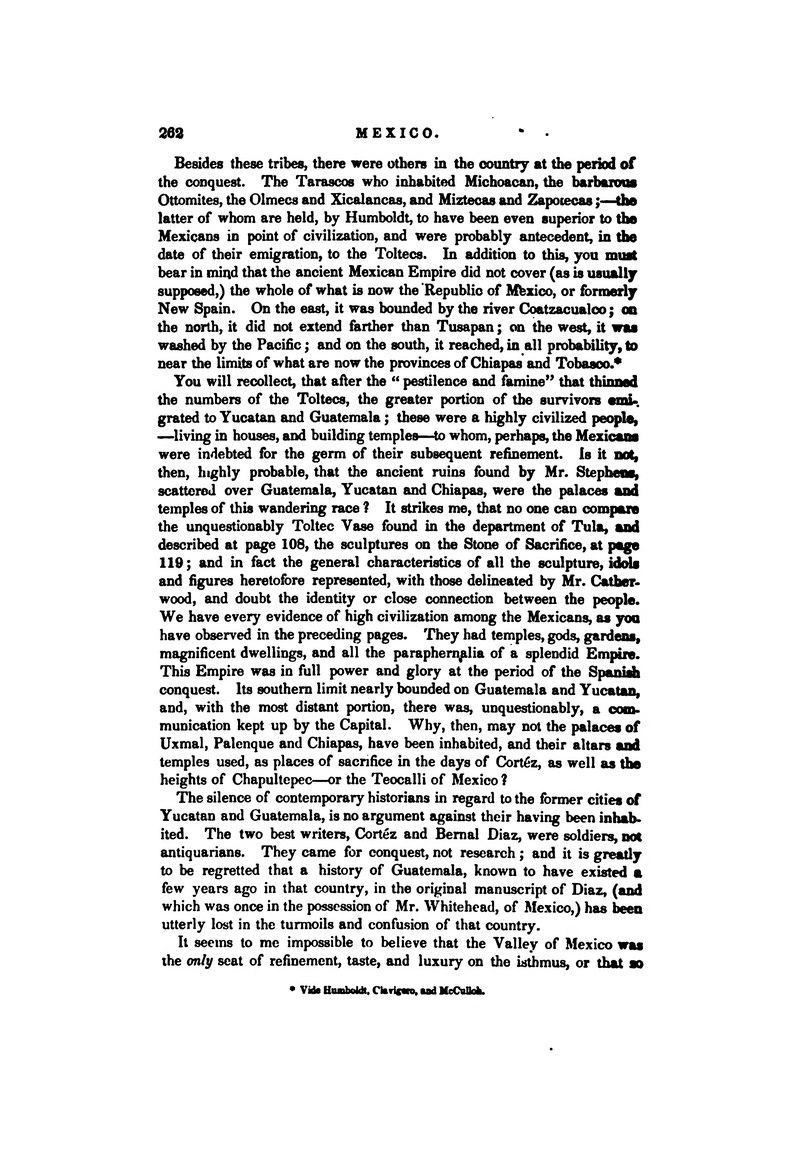Besides these tribes, there were others in the country at the period of the conquest. The Tarascos who inhabited Michoacan, the barbarous Ottomites, the Olmecs and Xicalancas, and Miztecas and Zapotecas;—the latter of whom are held, by Humboldt, to have been even superior to the Mexicans in point of civilization, and were probably antecedent, in the date of their emigration, to the Toltecs. In addition to this, you must bear in mind that the ancient Mexican Empire did not cover (as is usually supposed,) the whole of what is now the Republic of Mexico, or formerly New Spain. On the east, it was bounded by the river Coatzacualeo; on the north, it did not extend farther than Tusapan; on the west, it was washed by the Pacific; and on the south, it reached, in all probability to near the limits of what are now the provinces of Chiapas and Tobasco.[1]
You will recollect, that after the "pestilence and famine" that thinned the numbers of the Toltecs, the greater portion of the survivors emigrated to Yucatan and Guatemala; these were a highly civilized people,—living in houses, and building temples—to whom, perhaps, the Mexicans were indebted for the germ of their subsequent refinement. Is it not, then, highly probable, that the ancient ruins found by Mr. Stephens, scattered over Guatemala, Yucatan and Chiapas, were the palaces and temples of this wandering race? It strikes me, that no one can compare the unquestionably Toltec Vase found in the department of Tula, and described at page 108, the sculptures on the Stone of Sacrifice, at page 119; and in fact the general characteristics of all the sculpture, idols and figures heretofore represented, with those delineated by Mr. Catherwood, and doubt the identity or close connection between the people. We have every evidence of high civilization among the Mexicans, as you have observed in the preceding pages. They had temples, gods, gardens, magnificent dwellings, and all the paraphernalia of a splendid Empire. This Empire was in full power and glory at the period of the Spanish conquest. Its southern limit nearly bounded on Guatemala and Yucatan, and, with the most distant portion, there was, unquestionably, a communication kept up by the Capital. Why, then, may not the palaces of Uxmal, Palenque and Chiapas, have been inhabited, and their altars and temples used, as places of sacrifice in the days of Cortéz, as well as the heights of Chapultepec—or the Teocalli of Mexico?
The silence of contemporary historians in regard to the former cities of Yucatan and Guatemala, is no argument against their having been inhabited. The two best writers, Cortéz and Bernal Diaz, were soldiers, not antiquarians. They came for conquest, not research; and it is greatly to be regretted that a history of Guatemala, known to have existed a few years ago in that country, in the original manuscript of Diaz, (and which was once in the possession of Mr. Whitehead, of Mexico,) has been utterly lost in the turmoils and confusion of that country.
It seems to me impossible to believe that the Valley of Mexico was the only seat of refinement, taste, and luxury on the isthmus, or that so
- ↑ Vide Humboldt, Clavigero, and McCulloh.
